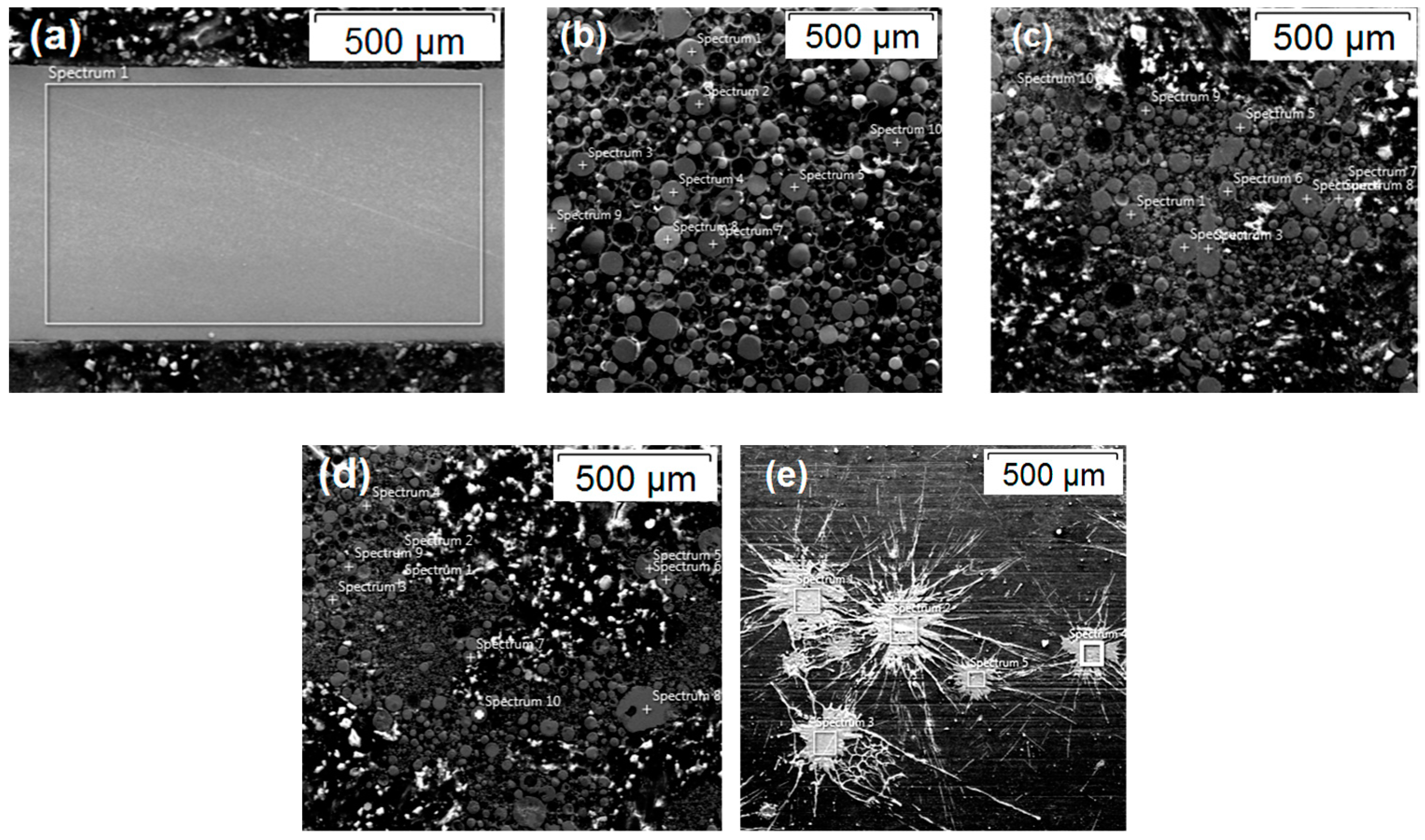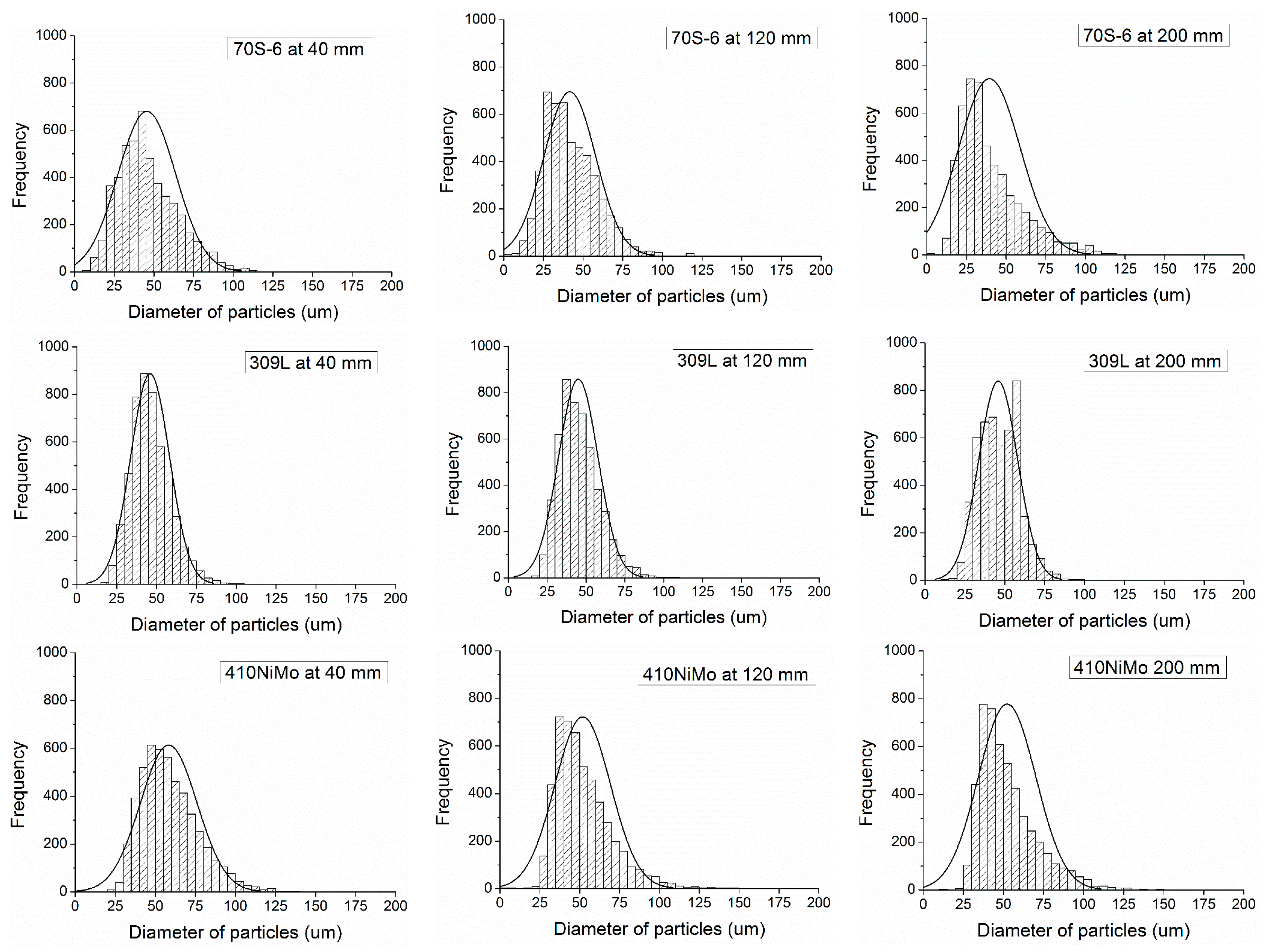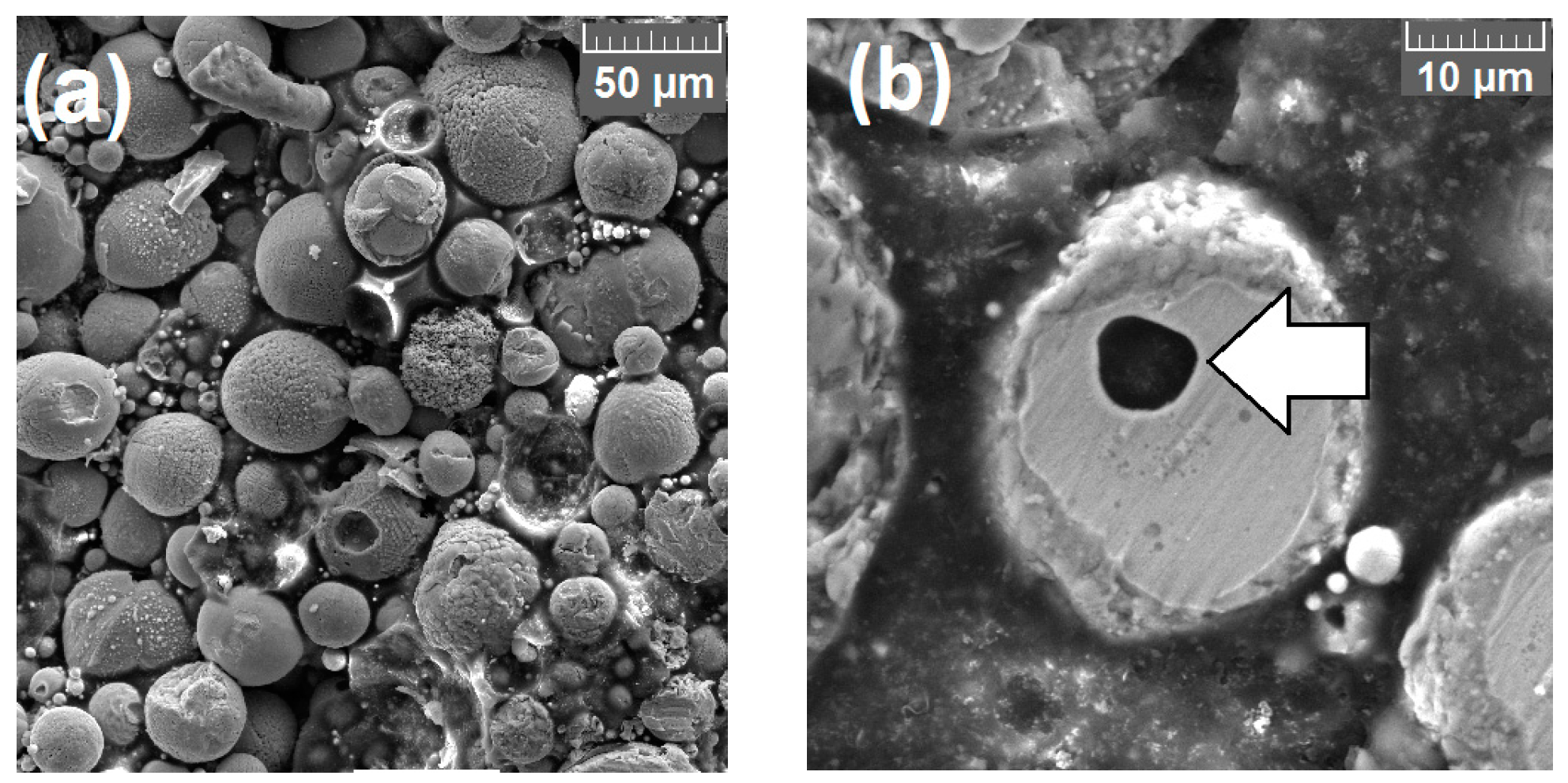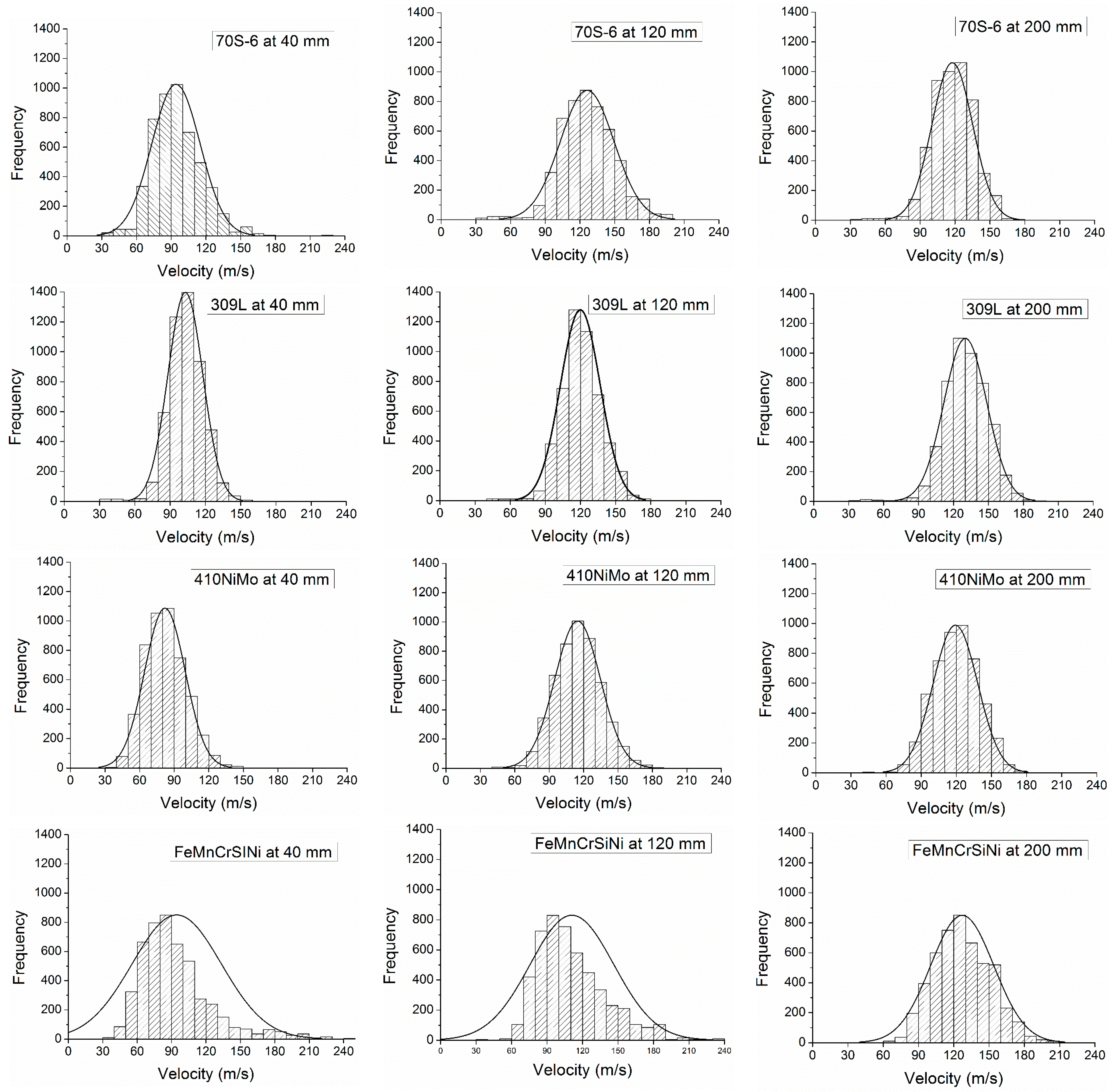Study of Particle Properties of Different Steels Sprayed by Arc Spray Process
Abstract
1. Introduction
2. Materials and Methods
3. Results and Discussions
3.1. Variation of Diameter of Droplets
3.2. Study of the Droplets Velocity
3.3. Study of the Droplets Temperature
3.4. Chemical Composition of the Droplets
4. Conclusions
Supplementary Materials
Author Contributions
Funding
Acknowledgments
Conflicts of Interest
References
- Padture, N.P.; Gell, M.; Jordan, E.H. Thermal barrier coatings for gas-turbine engine applications. Science 2002, 296, 280–284. [Google Scholar] [CrossRef] [PubMed]
- Uzun, A.; Çevik, I.; Akçil, M. Effects of thermal barrier coatings on a turbocharged Diesel engine performance. Surf. Coat. Technol. 1999, 116, 505–507. [Google Scholar] [CrossRef]
- Papavinasam, S.; Attard, M.; Arseneult, B.; Revie, R.W. State-of-the-art of thermal spray coatings for corrosion protection. Corros. Rev. 2008, 26, 105–145. [Google Scholar] [CrossRef]
- Matthews, S.; James, B. Review of thermal spray coating applications in the steel industry: Part 2–zinc pot hardware in the continuous galvanizing line. J. Therm. Spray Technol. 2010, 19, 1277–1286. [Google Scholar] [CrossRef]
- Wilden, J.; Bergmann, J.P.; Jahn, S.; Knapp, S.; van Rodijen, F.; Fischer, G. Investigation about the chrome steel wire arc spray process and the resulting coating properties. J. Therm. Spray Technol. 2007, 16, 759–767. [Google Scholar] [CrossRef]
- Biava, G.; Pukasiewicz, A.G.M.; Siqueira, I.B.A.F.; Vaz, R.F. Hot corrosion behavior of HVOF (Cr3C2 + 25NiCrAlY) and PVD (CrN) coating on a Waspaloy nickel-base superalloy in 60% V2O5 + 30% Na2SO4 + 10% NaCl environment: A comparative study. In Proceedings of the International Thermal Spray Conference ITSC2019, Yokohama, Japan, 26–29 May 2019. [Google Scholar]
- Ang, A.S.M.; Berndt, C.C. A review of testing methods for thermal spray coatings. Int. Mat. Rev. 2014, 59, 179–223. [Google Scholar] [CrossRef]
- Novicki, N.; Buschinelli, A.J.A.; Paredes, R.S.C. Amanteigamento por aspersão térmica na soldagem em operação de dutos de pequena espessura–estabilidade e penetração do arco voltaico. Soldag. Insp. 2011, 16, 243–255. [Google Scholar] [CrossRef]
- Costa, R.C.; Dacoreggio, M.V.; Comeli, F.W. Avaliação da resistência a corrosão de revestimentos metálicos depositados por aspersão térmica a arco: Uma aplicação em trocadores de calor. Soldag. Insp. 2014, 19, 292–301. [Google Scholar] [CrossRef][Green Version]
- Mehta, J.; Mittal, V.K.; Gupta, P. Role of thermal spray coatings on wear, erosion and corrosion behavior: A review. J. Appl. Sci. Eng. 2017, 20, 445–452. [Google Scholar] [CrossRef]
- Sucharski, G.B.; Pukasiewicz, A.G.M.; Vaz, R.F.; Paredes, R.S.C. Optimization of the deposition parameters of HVOF FeMnCrSi+Ni+B thermally sprayed coatings. Soldag. Insp. 2015, 20, 238–252. [Google Scholar] [CrossRef]
- Pukasiewicz, A.G.M.; Alcover, P.R.C., Jr.; Capra, A.R.; Paredes, R.S.C. Influence of plasma remelting on the microstructure and cavitation resistance of arc-sprayed Fe-Mn-Cr-Si alloy. J. Therm. Spray Technol. 2014, 23, 51–59. [Google Scholar] [CrossRef]
- Kwok, C.T.; Cheng, F.T.; Man, H.C. Laser-fabricated Fe-Ni-Co-Cr-B austenitic alloy on steels. Part 1: Microstructures and cavitation behavior. Surf. Coat. Technol. 2001, 145, 194–205. [Google Scholar] [CrossRef]
- Yuping, W.; Pinghua, L.; Cheglin, C.; Zehua, W.; Ming, C.; Junhua, H. Cavitation erosion characteristics of a Fe-Cr-Si-B-Mn coating fabricated by high velocity oxy-fuel (HVOF) thermal spray. Mater. Lett. 2007, 61, 1867–1872. [Google Scholar] [CrossRef]
- Pukasiewicz, A.G.M.; de Oliveira, F.R.; Capra, A.R.; Paredes, R.S.C. Influência da refusão por plasma na microestrutura de um revestimento Fe–Mn–Cr–Si depositado por aspersão térmica arco elétrico sobre aço inoxidável ASTM A743-CA6NM. Soldag. Insp. 2012, 17, 65–75. [Google Scholar] [CrossRef][Green Version]
- Kelkar, M.; Hiberlein, J. Wire-arc spray modeling. Plasma Chem. Plasma Process. 2002, 22, 1–25. [Google Scholar] [CrossRef]
- Scotti, A.; Ponomarev, V.; Lucas, W. A scientific application oriented classification for metal transfer modes in GMA welding. J. Mater. Process. Tech. 2012, 212, 1406–1413. [Google Scholar] [CrossRef]
- Lunn, G.D.; Riley, M.A.; McCartney, D.G. A study of wire breakup and in-flight particle behavior during wire flame spraying of aluminum. J. Therm. Spray Technol. 2017, 26, 1947–1958. [Google Scholar] [CrossRef]
- Crawmer, D.E. Thermal spray process. In Handbook of Thermal Spray Technology; Davis, J.R., Ed.; ASM: Novelty, OH, USA, 2004; pp. 54–73. [Google Scholar]
- Crawmer, D.E. Coating structures, properties, and materials. In Handbook of Thermal Spray Technology, Davis, J.R., Ed.; ASM: Novelty, OH, USA, 2004; pp. 47–52. [Google Scholar]
- Planche, M.P.; Liao, H.; Coddet, C. Relationships between in-flight particle characteristics and coatings microstructure with a twin wire arc spray process and different working conditions. Surf. Coat. Technol. 2004, 182, 215–226. [Google Scholar] [CrossRef]
- Friis, M.; Nylén, P.; Person, C.; Wigren, J. Investigation of particle in-flight characteristics during atmospheric plasma spraying of yttria-stabilized ZrO2: Part 1: Experimental. J. Therm. Spray Technol. 2001, 10, 301–310. [Google Scholar] [CrossRef]
- Friis, M.; Person, C.; Wigren, J. Influence of particle in-flight characteristics on the microstructure of atmospheric plasma sprayed yttria stabilized ZrO2. Surf. Coat. Technol. 2001, 141, 115–127. [Google Scholar] [CrossRef]
- Zhang, N.; Lin, D.; Li, Y.; Zhang, Y.; Planche, M.P.; Liao, H.; Coddet, C.; Dong, F. In-flight particle characterization and coating forming under low pressure plasma spray condition. J. Iron Steel Res. Int. 2017, 24, 306–312. [Google Scholar] [CrossRef]
- Valarezo, A.; Choi, W.B.; Chi, W.; Gouldstone, A.; Sampath, S. Process control and characterization of NiCr coatings by HVOF-DJ2700 system: A process map approach. J. Therm. Spray Technol. 2010, 19, 852–865. [Google Scholar] [CrossRef]
- Steffens, H.D.; Nassenstein, K. Influence of the spray velocity on arc-sprayed coating structures. J. Therm. Spray Technol. 1999, 8, 454–460. [Google Scholar] [CrossRef]
- Bobzin, K.; Kopp, N.; Warda, T.; Petkovic, I.; Shaefer, M.; Landes, K.D.; Forster, G.; Zimmermann, S.; Marques, J.L.; Kirner, S.; et al. Particle in-flight and coating properties of Fe-based feedstock materials sprayed with modern thermal spray systems. J. Therm. Spray Technol. 2012, 22, 363–370. [Google Scholar] [CrossRef]
- Champagne, V.K.; Helfritch, D.J.; Dinavahi, S.P.G.; Leyman, P.F. Theoretical and experimental particle velocity in Cold Spray. J. Therm. Spray Technol. 2010, 20, 425–431. [Google Scholar] [CrossRef]
- Hale, D.L.; Swank, W.D.; Haggard, D.C. In-flight particle measurements of twin wire arc sprayed aluminum. J. Therm. Spray Technol. 1998, 7, 58–63. [Google Scholar] [CrossRef]
- Newbery, A.P.; Grant, P.S. Oxidation during electric arc spray forming of steel. J. Mater. Process. Tech. 2006, 178, 259–269. [Google Scholar] [CrossRef]
- Rodriguez, R.M.H.P.; Paredes, R.S.C.; Wido, S.H.; Calixto, A. Comparison of aluminum coatings deposited by Flame Spray and Electric Arc Spray. Surf. Coat. Technol. 2007, 202, 172–179. [Google Scholar] [CrossRef]
- Fauchais, P.; Vardelle, A.; Dussoubs, B. Quo vadis thermal spraying. J. Therm. Spray Technol. 2001, 10, 44–66. [Google Scholar] [CrossRef]
- American Welding Society AWS A5.18. Specification for Carbon Steel Electrodes and Rods for Gas Shielded Arc Welding; AWS: Miami, FL, USA, 1993. [Google Scholar]
- American Welding Society AWS A5.9. Specification for Bare Stainless Steel Welding Electrodes and Rods; AWS: Miami, FL, USA, 1993. [Google Scholar]
- Capra, A.R.; Vaz, R.F.; Pukasiewicz, A.G.M.; Paredes, R.S.C.; Procopiak, L.A.J. Liga Ferrosa Contendo Manganês, Cromo, Silício e Boro Com Elevada Resistência à Cavitação e Componente Sujeito à Erosão Por Cavitação Contendo o Mesmo; Brazil PI-BR 10 2016 029054 6, 2016. (In Portuguese) [Google Scholar]
- Katanoda, H.; Matsuo, K. Analysis of particle behavior in high-velocity oxy-fuel thermal spraying process. J. Therm. Spray Tech. 2003, 12, 279–282. [Google Scholar] [CrossRef]
- Syed, A.A.; Denoirjean, A.; Denoirjean, P.; Labbe, J.C.; Fauchais, P. In-flight oxidation of stainless steel particles in plasma spraying. J. Therm. Spray Technol. 2005, 14, 117–124. [Google Scholar] [CrossRef]
- Berndt, C.C. Materials production processes. In Handbook of Thermal Spray Technology; Davis, J.R., Ed.; ASM: Novelty, OH, USA, 2004; pp. 147–153. [Google Scholar]
- Pawlowski, L. The Science and Engineering of Thermal Spray Coatings, 2nd ed.; Wiley: West Sussex, UK, 2008. [Google Scholar]
- Li, M.; Christofides, D. Computational study of particle in-flight behavior in the HVOF thermal spray process. Chem. Eng. Sci. 2006, 61, 6540–6552. [Google Scholar] [CrossRef]
- Djebali, R.; Pateyron, B.; Ganaoui, M. A lattice Boltzmann based investigation of powder in-flight characteristics during APS process, part II: Effects of parameter dispersions at powder injection. Surf. Coat. Technol. 2013, 220, 157–163. [Google Scholar] [CrossRef]
- Balic, E.E.; Hadad, M.; Bandyopadhyay, P.P.; Michler, J. Fundamentals of adhesion of thermal spray coatings: Adhesion of single splats. Acta Mater. 2009, 58, 5921–5926. [Google Scholar] [CrossRef]
- Deshpande, S.; Sampath, S.; Zhang, H. Mechanisms of oxidation and its role in microstructural evolution of metallic thermal spray coatings–case study for Ni-Al. Surf. Coat. Technol. 2006, 200, 5395–5406. [Google Scholar] [CrossRef]
- Sheir, L.L.; Jarman, R.A.; Burstein, G.T. Corrosion: Metal/Environment Reactions, 3rd ed.; Butterworth-Heinmann: Oxford, UK, 1994. [Google Scholar]










| Voltage | Current | Standoff Distance | Atomizing Gas Pressure |
|---|---|---|---|
| 30 V | 180 A | 40 mm | 55 psi (380 kPa) |
| 80 mm | |||
| 120 mm | |||
| 160 mm | |||
| 200 mm |
| Material | C | Cr | Ni | Mo | Mn | Si | B | Fe |
|---|---|---|---|---|---|---|---|---|
| AWS A5.18 ER70S-6 [33] | 0.06 0.15 | – | – | – | 1.40 1.85 | 0.80 1.15 | – | Bal. |
| AWS A5.9 ER309LSi [34] | 0.03 | 23.00 25.00 | 12.00 14.00 | 0.75 | 1.00 2.50 | 0.65 1.00 | – | Bal. |
| AWS A5.9 ER410NiMo [34] | 0.06 | 11.00 12.50 | 4.00 5.00 | 0.40 0.70 | 0.60 | 0.50 | – | Bal. |
| FeMnCrSiNi [35] | 0.50 max | 8.00 16.00 | 5.00 max | – | 10.00 30.00 | 2.00 6.00 | 2.00 max | Bal. |
| Material | Condition | Cr | Ni | Mo | Mn | Si | Fe |
|---|---|---|---|---|---|---|---|
| 70S-6 | Wire | – | – | – | 1.5 ± 0.1 | 1.2 ± 0.1 | Bal. |
| Particles | – | – | – | 1.2 ± 0.1 | 1.2 ± 0.1 | Bal. | |
| Lamellae | – | – | – | 1.2 ± 0.1 | 0.9 ± 0.1 | Bal. | |
| 309L | Wire | 24.2 ± 0.2 | 13.0 ± 0.2 | 0.3 ± 0.2 | 2.0 ± 0.1 | 1.0 ± 0.1 | Bal. |
| Particles | 21.4 ± 0.2 | 13.9 ± 0.2 | 0.4 ± 0.3 | 1.1 ± 0.1 | 0.2 ± 0.1 | Bal. | |
| Lamellae | 20.4 ± 0.2 | 13.2 ± 0.3 | 0.3 ± 0.2 | 0.9 ± 0.1 | 0.2 ± 0.1 | Bal. | |
| 410NiMo | Wire | 12.9 ± 0.1 | 3.8 ± 0.1 | 0.5 ± 0.2 | 0.9 ± 0.1 | 1.2 ± 0.1 | Bal. |
| Particles | 12.5 ± 0.1 | 4.1 ± 0.2 | 0.4 ± 0.3 | 0.7 ± 0.1 | 0.5 ± 0.1 | Bal. | |
| Lamellae | 12.4 ± 0.2 | 3.8 ± 0.2 | 0.4 ± 0.3 | 0.6 ± 0.1 | 0.3 ± 0.1 | Bal. | |
| FeMnCrSiNi | Wire | 17.0 ± 0.6 | 5.0 ± 0.2 | – | 10.2±0.4 | 8.9 ± 0.3 | Bal. |
| Particles | 17.3 ± 0.2 | 5.2 ± 0.2 | – | 7.1±0.3 | 6.3 ± 0.1 | Bal. | |
| Lamellae | 17.2 ± 0.6 | 5.2 ± 0.2 | – | 6.1±0.3 | 6.8 ± 0.3 | Bal. |
© 2020 by the authors. Licensee MDPI, Basel, Switzerland. This article is an open access article distributed under the terms and conditions of the Creative Commons Attribution (CC BY) license (http://creativecommons.org/licenses/by/4.0/).
Share and Cite
Vaz, R.F.; Pukasiewicz, A.G.M.; Fals, H.D.C.; Lourençato, L.A.; Paredes, R.S.C. Study of Particle Properties of Different Steels Sprayed by Arc Spray Process. Coatings 2020, 10, 417. https://doi.org/10.3390/coatings10040417
Vaz RF, Pukasiewicz AGM, Fals HDC, Lourençato LA, Paredes RSC. Study of Particle Properties of Different Steels Sprayed by Arc Spray Process. Coatings. 2020; 10(4):417. https://doi.org/10.3390/coatings10040417
Chicago/Turabian StyleVaz, Rodolpho F., Anderson G. M. Pukasiewicz, Hipólito D. C. Fals, Luciano A. Lourençato, and Ramon S. C. Paredes. 2020. "Study of Particle Properties of Different Steels Sprayed by Arc Spray Process" Coatings 10, no. 4: 417. https://doi.org/10.3390/coatings10040417
APA StyleVaz, R. F., Pukasiewicz, A. G. M., Fals, H. D. C., Lourençato, L. A., & Paredes, R. S. C. (2020). Study of Particle Properties of Different Steels Sprayed by Arc Spray Process. Coatings, 10(4), 417. https://doi.org/10.3390/coatings10040417






